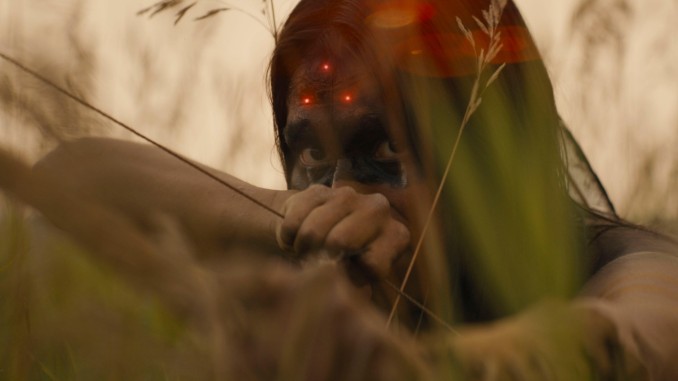Indigenous Reinvention Prey Is the Best Predator Since the Original

Filmmaker Dan Trachtenberg’s Predator prequel Prey succeeds by daring to embrace what prior sequels did not: Simplicity. The basics of Predator cinema boil down to skull trophies and rival combat, but most of all, the thrill of an uninterrupted hunt. With brutal ease, writer Patrick Aison translates Predator codes to hunter-gatherer dichotomies in Native American cultures. There’s nothing scarier than the laws of natural hierarchies on display in their most elemental forms, and that’s what Prey recognizes with menacing regard. There’s nothing wrong with going bigger, but there’s always been something missing in previous Predator continuations that get preoccupied elsewhere. Trachtenberg understands what Predator fans crave, and executes without mercy.
Set in the Northern Great Plains of 1719, Prey pits a Predator challenging any species’ alphas—wolves, bears, people—against a Comanche tribe. Taabe (Dakota Beavers) leads other boys on hunts while his sister Naru (Amber Midthunder) practices her deadliest skills in secrecy. She’s dismissed by most for her gender, but not by Taabe. Naru’s chance to defeat a lion (thanks to Taabe) and earn her warrior’s rite of passage fails when a Predator’s alien technology distracts from afar—which no one believes. Only Naru can protect her family and tribespeople from the unknown Yautja threat since no one will listen, which will be the warrior-wannabe’s ultimate test.
Let’s not pretend Prey is a subtle war waged against gender norms. Naru challenges her tribe’s adherence to domesticated roles, where men collect meat and women stoke fires under pots. Aison’s story is about insatiable determination, about not letting others dictate your fate and readapting Predator from the reverse empowerment of macho dudes—which flexes similarly entertaining muscles. Trachtenberg never shies away from heavy-handed representation strides, but it’s neither forceful nor disingenuous. Naru’s cunning and tracking skills are paramount to her success, as are her helpful allies in Taabe or timely distractions from other more dispensable Comanche search parties. Trachtenberg humbly honors bloodthirsty and bone-crushing Predator mechanics while fiercely challenging the same genre norms Naru faces in Comanche Nation.
Trachtenberg’s attention to period details—from French fur trappers to Comanche combat strategies—favors originality. Almost the entire cast is Native and First Nation talent, and a Comanche dub will be available to the public upon release; composer Sarah Schachner beats rapturous rhythms backed by incensed howls and war cries that embolden the atmosphere. This 300-year-old action thriller is still intensely heart-pounding despite arrows and axes being the Comanche’s only weapons against an earlier-era Predator. There are technology downgrades on both sides (human vs. extraterrestrial), but that doesn’t bridge the extraordinary gap between Naru and her bug-ugly foe—which only enhances her uphill journey.
There’s a scene between Naru and the French that gets a little wonky, with characters speaking through “translations” in the English version, but outside this understandably weird situation (American markets might pass on subtitles), Trachtenberg spotlights Comanche authenticity.
-

-

-

-

-

-

-

-

-

-

-

-

-

-

-

-

-

-

-

-

-

-

-

-

-

-

-

-

-

-

-

-

-

-

-

-

-

-

-

-








































